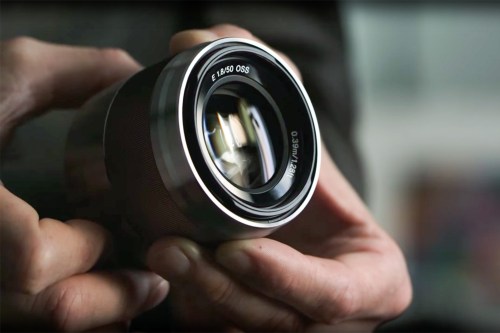
Cleaning the front and rear elements
First, you want to clean the front and rear elements of the lenses. For obvious reasons, these two optical elements are the most likely to get dirty when shooting day-to-day, the front element in particular. Before opting for a traditional cleaning cloth, however, what you’ll want to do is use a blower bulb. We suggest the Giotto Rocket Blaster, as it’s an age-old tool used by photographers around the world for decades. Using a blower bulb helps to gently remove any dust or dirt on your lens that would otherwise be ground into the glass when wiping it with a cloth.
Once you’ve finished blowing off the element, you’re going to want to obtain a microfiber cloth and cleaning solution. Microfiber cloths vary in terms of texture and quality, so be sure to find one that doesn’t leave behind any unwanted fuzzies. Also, when using the cleaning solution in conjunction with the cloth, avoid spraying the solution directly on the optical elements. Instead, spray the solution on the cloth and wipe accordingly. If there are streaks left behind, use a dry section of the microfiber cloth to ensure a clean surface.
Cleaning the outside of lens
You might not find yourself cleaning the outside of your lens often, but when you do, you’ll want to make sure you’re doing it right. A microfiber cloth works wonders for getting dust and dirt off the outside of the lens, and for those times when you want to give your lens a deeper cleaning, a toothbrush is your best friend.
Specifically, get a soft-bristled toothbrush and, without any sort of liquid cleaner, brush across the surfaces and inside the crevices of your lens. The bristles on the brush should dislodge any dirt that might’ve built up between the focus and zoom rings.
Although many lenses claim to be “waterproof” or “weatherproof,” the truth is, no lens is completely protected from liquids. Because of this, we suggest you avoid using liquid cleaners on the barrel of your lens. If you do find it absolutely necessary to do so, remember to place the cleaning solution on the microfiber cloth — not on the lens directly.
Lens contacts
Newer lenses have electronic contacts on the lens mount that drive the focusing motor, the image stabilization setup (if present), and help transfer information about the image and lens to the camera body. For the most part, you should never have to worry about these contacts. In fact, it’s best to avoid cleaning them as much as possible, since they’re often made of sensitive metals.
But, in the event you’re getting a constant error code regarding the connection between the lens and the camera, your safest bet is to clean the camera with a standard pencil eraser. Make sure the eraser you’re using is made of a soft rubber, as certain erasers may contain abrasives that could scratch the contacts. Furthermore, ensure the lens is facing down so that shavings don’t find their way into the internal components of the lens. Again, only do this as a last-ditch effort.
Leave it to the pros
If you aren’t much of a do-it-yourselfer or you aren’t comfortable doing the steps mentioned above, then it’s possible you could accidentally damage a lens. In this instance, you should leave it to the professionals. Yes, it will cost you out of pocket, but if lens cleaning is something you do once in a while, then the money spent could be a sound investment.
Many specialty camera retailers will offer in-store lens cleaning. Even Best Buy offers such a service through its Geek Squad division. You can also check with your camera manufacturer’s customer service, which could direct you to the appropriate place for lens cleaning. If you live near one of Canon’s service centers, such as the one in Lyndhurst, New Jersey, you could even drop off a lens and have a Canon technician not only clean it, but diagnose it for possible problems.
Wrapping it up
Overall, keeping your lens working like a well-oiled machine shouldn’t take too much work once you have the required tools on hand. This is especially if you properly attach and remove it from your camera, adding both the front and rear lens caps.
If your lens has more profound problems than those mentioned in this article, or has a build up of dirt on the internal optical elements, your best bet is to contact your camera manufacturer about getting it professionally cleaned. Whether talking a manufacturer’s in-house service or that of a third party, taking care of gear is what these people do. And, trust us, it’s better to spend a couple hundred dollars having your shooter professionally cleaned than to try and do it yourself only to ruin an expensive lens.
Editors' Recommendations
- Best microSD cards in 2023: top picks for your computer, camera, or drone
- How to use smart lights to up your photography skills
- The best camera apps for Android
- The best cameras for kids
- The best camera straps for 2021